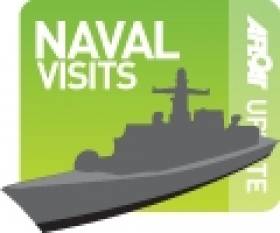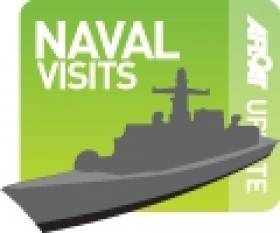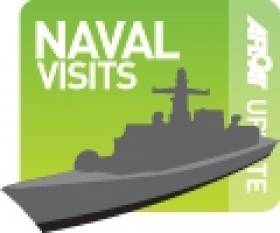Displaying items by tag: Naval Visits
‘Stealth’ Designed Dutch Class Frigate Calls to Dublin Port
#DutchStealthFrigate - An air-defence and command frigate (LCF) of the Royal Netherlands Navy HNLMS De Zeven Provinciën (F802) docked in Dublin Port today for a three-day visit, writes Jehan Ashmore.
The Dutch Embassy in Ireland through Ambassador Schellekens has cordially invited the general public to an open viewing/tour on Saturday 12th September.
This offer should be recognised and welcomed given the berth location of the frigate is in the heart of the port rather than the more usual berthing of foreign naval ships at the more accessible city-centre location along Sir John Rogersons Quay.
The tour begins at 11am (noting, to book a place is on a first served basis and requiring private transport to reach Ocean Pier accessed via Alexandra Basin).
It is strongly advisable to bring a Photo ID and to carefully read for further instructions, (before emailing of this boarding opportunity) by clicking the Embassy link HERE.
The ‘Provinciën’ class fast-frigate (30 knots) which carries missiles is the leadship of a quartet commissioned in 2002.
She along with her sisters of 6,050 tonnes, have a striking stealth design technology in that the superstructure has sharp angular angles to reduce radar signature.
All of the frigates were built by Royal Schelde which completed the final newbuild in 2005 thus completing a programme to replace the ‘Tromp’ class and ‘Jacob van Heesmarck’ Class frigates.
The armament of the ‘Provinciën’ class, are as listed: Oto Breda 127mm cannon, Vertical Launch System (VLS) Mk 41 for Enhanced Sea Sparrow Missile (ESSM) and Standard Missile (SM), Harpoon Missile (HM), Goalkeeper (rapid-fire gun), Mk. 46 Torpedo weapon system, NH-90 helicopter.
In 2013 off the US north-east coast she carried out exercises in the firing of an ESSM, a SM and two HM’s (see video above).
On her arrival to Dublin Bay, the frigate took on a pilot from cutter Camac off Howth from where she continued on into the port approach channel.
While this was taking place, the Dublin Port tug sisters Beaufort and Shackleton were awaiting within the port fairway to carry out in assisting the berthing of the 144m long frigate alongside Ocean Pier. The berth, No. 35 is located on the fairway between the West and East of the Alexandra Basins.
Upriver beyond the East-Link toll lift bridge is where another foreign navy visitor, the German Navy sail-trainee barque Gorch Fock has graced the south quays.
The three-masted ship will also be open to the public next weekend, albeit only on the following Sunday, 13th September. For further details of “Open Ship” tours click to our previous coverage here.
Also calling to the capital during the summer was the Royal Navy frigate HMS Monmouth (F235), she along with her ‘Duke’ class frigates are quite regular visitors to the port.
#RoyalFrigate – A Royal Navy frigate is joining in the Belfast Tall Ships Races Festival which has 45 tallships visiting the city including a record 17 of the largest 'A' Class full-rigged vessels, writes Jehan Ashmore.
The Type 23 Duke class frigate HMS Northumberland (F238) is berthed in Pollock Dock and will be open to the public at certain times.
When not tasked on deployments the frigate commissioned in 1994 is based in her homeport of Devon, Cornwall. She along with the impressive A class tallships and those of the B,C and D classes are visiting the city which is also hosting the Belfast Titanic Maritime Festival.
In addition to boarding the 133m frigate of course will be opportuity to step on the decks of the Tallships which are also berthed on the Lagan and close to the Belfast Titanic Quarter. Tallships of all sizes and from many nations are berthed. Among them is the Brazilian Navy's clipper Cisne Branco meaning the 'White Swan'.
Announcements regarding vessel opening times will be notified to visitors over the course of the four –day festival that began yesterday and continues to this Sunday 5 July.
A total of 500,000 visitors are expected to throng the city's quays and the shores of Belfast Lough notably for the festival's maritime spectacle of the Parade of Sail on the Sunday from 11am!
To see the list of all participating tallships, events and much more visit http://tallshipsbelfast.com/
#CanadianFrigate– HMCS Fredericton (FFH 337) a Canadian Navy Halifax-class frigate with a crew of 250 personnel of all ranks is on a visit to Cork City Quays having arrived in recent days, writes Jehan Ashmore.
The frigate berthed at J.J. Horgans Wharf has an extensive suite of anti-submarine warfare and anti-surface warfare weapons. In addition sensors to complement their substantial anti-air warfare defences.
HMCS Fredericton has been in service for 21 years with the Canadian Forces since her commissioning in 1994.
The 134m frigate represents the eighth ship in her class of 12 that are the backbone of the Canadian Navy. The class are based on the Canadian Patrol Frigate Project and they are capable of carrying a CH-124 Sea King helicopter.
In April she was understood to have taken part in NATO exercises held off Scotland.
The visitor is expected to depart Cork on Saturday and head for St. John's in Newfoundland.
#TurkishSubmarine – A Turkish Navy submarine that was to call to Dublin Port last month to coincide with the centenary of Irish troops in the Gallipoli Campaign of WWI as previously reported on Afloat.ie, did not dock, as it transpired, due to 'technical' reasons, writes Jehan Ashmore.
The Gür class missile-carrying submarine TCG Burakreis (S-359) was scheduled to make a courtesy call to Dublin Port to mark the centenary of Anzac Day (25th April 1915). In addition the visit was to enhance present day relationships between the two republics.
Prior to Anzac Day, which saw international figures among them President Higgins attend the main ceremonies held on the Turkish Peninsula, the 1,586 (dived) tons submarine was in Scottish waters to where NATO exercises took place.
During the Burakreis Scottish manouveres, the 62m long, 8,500 nautical mile range submarine was in the Firth of Clyde. When off Gourock for example, the submarine was in the vicinity of an Arklow Shipping Ltd general cargsoship. The anchored 'R' class vessel being one of ASL's Dutch division based ships registered in Rotterdam.
As part of the NATO exercises, it is understood to have included a German naval flotilla of seven ships. The flotilla called to Cork Harbour during the 'Anzac' weekend in advance of last Thursday's RMS Lusitania centenary commemorative events where President Higgins also attended.
#CorkHarbour - Following today's earlier news of a French naval visit to Dun Laoghaire Harbour comes word from TheJournal.ie of a courtesy call by the German navy at Cork Harbour this weekend.
Seven German vessels will be stopping by till Monday 27 April restocking supplies and giving their crews some well earned shore leave.
But they're also sure to pause and reflect on the 100 years since the sinking of the Lusitania by a U-boat representing a very different Germany in the First World War.
Commemorations for those who died in the tragedy began in Cork Harbour on 1 February and will continue till the anniversary on 7 May.
#GallipoliCentenary - The visit of a Turkish Navy submarine TCG Burakreis (S-359) to Dublin Port next Saturday is according to the Turkish Embassy as a sign of friendship and enhanced relationships between the two countries, writes Jehan Ashmore.
The 1,586 tons (dived) Gür class submarine call later this week on Anzac Day (25 April 1915) is when exactly 100 years ago among the Allied Forces of Australia and New Zealand, Irish soldiers fought at the Gallipoli Campaign during World War I.
When the 62m long, 8,500 nautical mile range missile carrying submarine docks in Dublin, the historical connection will be highlighted as the 1st Battalion of the Royal Dublin Fusiliers and came under fire in Gallipoli.
In addition the visit will also have reasonace in that during the Great Irish Famine, humanitarian assistance was provided by Sultan Abdülmecit in 1847.
Next Saturday's centenary call will mark when the naval bombardment in Gallipoli stopped and the skipper of the steam collier S.S. River Clyde, Commander Unwin, ran her aground on the beach just under the ancient Fort at Sedd-el-Bahr at the Turkish peninsula.
It was here that Dublin and Munster Fusiliers on board S.S. River Clyde took part in the Cap Hellas Landings when they arrived off the southern tip of the peninsula. At a section was 'V' beach that was assigned to the fusiliers who were also joined from the ship by the Royal Hampshire Regiment.
The 2,000 men did not stand a chance when they landed onto the beach according to the www.dublin-fusiliars.com website, which has much more on this sad episode of Irish history and that the Allied commanders believed in controlling the Dardanelles they could have ended the war by forcing a negotiated settlement without the intervention of the United States.
In attacking the Dardanelles the plan by the First Lord of the Admiralty, Winston Churchill, was to draw German troops from the Western Front to help Turkey.
Further northwards from Cape Helles headland is where Australians and New Zealand forces tried to land as well as part of the Anzac Cove Landings. The combined forces were too held back by the Turks.
According to today's Irish Times, a week-long visit by President Michael D. HIggins to Turkey and Lebanon is to represent Ireland during 100th anniversary commemorations of the Gallipoli landings and will afterwards visit Irish troops serving with Unifil.
The President will be accompanied by Minister for Foreign Affairs Charlie Flannagan; the Chief of Staff of the Defence Forces, Lieut-Gen Conor O'Boyle; two service personnel from each of the three branches of the Defence Forces, the Army, Air Corps and Naval Service, and a piper, Sgt Joe Meade, from 7 Infantry Battalion.
It is the first time the Defence Forces will participate in such strength at the Gallipoli commemorations. The main Allied memorial ceremony, which will take place on Friday at the Helles Memorial, has been titled the Commonwealth and Ireland Service.
President Higgins will participate in separate Turkish and French commemorations and at the Anzac memorial service, at dawn on April 25th, Anzac Day.
The newspaper adds that throughout the campaign some 3,000 Irishmen died between April 24th until the end of 1915 and this had included the disastrous August landings at Suvla Bay.
To read more from the Irish Times, click here.
#RugbyRoyal – HMS Portland (F79) a Royal Navy frigate docked in Dublin Port is on for a private-visit and comes in advance of the today's eagerly awaited RBS Six Nations fixture of Ireland versus England, writes Jehan Ashmore.
The Type 23 'Duke' class frigate with 185 crew personal are on shore-leave visit to the capital having arrived on Friday as part of long weekend call.
The rugby venue close to the city centre is the Aviva Stadium which backs onto the banks of the Dodder. This river is a tributary of the Liffey that flows into the port at Ringsend, where downriver is berthed HMS Portland. Also in port is the Naval Service OPV LÉ Aisling (P23), which arrived yesterday and moored alongside the Liffey quays.
Likewise of the Devonport based Royal Naval frigate, the now sole remaining 'Emer' class OPV had also approached Dublin Bay from a northerly direction.
HMS Portland is currently deployed for seven-months as an Atlantic Patrol Ship that is tasked to undertake maritime security operations.
The frigate's arrival to Dublin Bay involved taking a pilot from the cutter Liffey off the Baily Lighthouse. When entering port, sister tugs Beaufort and Shackleton were in attendance.
The 133m frigate is one of the youngest in the Duke-class having been launched on the Clyde in 1999 and commissioned into RN service two year later. They were designed to deal with the Soviet submarine threat.
Among her principle characteristics, she can reach a top speed of 28 knots and has a range of 7,800 nm. As for defence and weapons, they include Seawolf Guided Missiles, Harpoon Long Range Anti-Ship Missiles, MK8 medium range guns and small calibre guns.
French Navy Hosts Irish D-Day Veteran's Légion d’Honneur Ceremony
#LégionDhonneur – The French Navy's BCR Somme (A 631) hosted one of the last surviving Irish veterans of the D-Day landings and who received the nation's highest military honour today in Dublin Port.
Michael d'Alton (93) received the Légion d'Honneur on board the command logistics supply-ship which as previously reported on Afloat.ie is on a courtesy visit of the capital.
Mr d'Alton was a sub-lieutenant on a landing craft bringing Sherman tanks across to Omaha Beach in the American sector on June 6th, 1944.
The landings at the beach inspired the opening sequence of the film Saving Private Ryan. It was based on the experience of the first companies of American soldiers who tried to take the heavily fortified Dog Green sector of the beach.
For more on this story, The Irish Times reports HERE.
French Navy Command, Logistics Supply Ship 'Somme' Calls to Dublin Port
#CommandShip – A French Navy command and supply ship BCR Somme (A 631), one of a series of oil tankers serving the fleet, is currently on a visit to Dublin Port, writes Jehan Ashmore.
Somme belongs to the Naval Action Force (Fan), Organic command of surface ships of the navy and is under the operational command of the commander of the maritime area of the Atlantic.
Laid down in 1985 at the Naval Yard in Brest, Brittany, the Somme which has a displacement of 7,800 tons and 18,000 tons at full load, was commissioned five year later. She is primarily used to be deployed in serving naval forces away from their bases during overseas missions.
The provisioning of supplies carried out by Somme involves various fuels (oil, diesel and jet fuel) in addition to water, food, drugs and ammunition and alternative materials. Heavy loads ranging from food, munitions and materials are transferred by sea cable support or by helicopter.
She is sponsored by the city of Amiens since 1990 and that of the Somme department was made the following year. In more recent years, her homeport has been based in Brest.
A departure from Dublin Port is scheduled for Tuesday morning.
Royal Fleet Auxiliary Replenishment Tanker On Five-Day Courtesy Call
#RFAtanker – A UK tanker of the Royal Fleet Auxiliary, RFA Gold Rover (A271) that has a supporting role in the Royal Naval, arrived into a foggy Dublin Bay to dock in the capital for a five-day courtesy visit, writes Jehan Ashmore.
The visit of RFA Gold Rover of 11,522 tonnes displacement coincides on this UK August Bank Holiday Monday and notably she is a rare visitor to an Irish port given that she is a member of the Royal Fleet Auxiliary.
Her visit follows another important large British naval caller when the Royal Navy's HMS Illustrious (R06) as previously reported on Afloat.ie called to the capital in April 2013. This was to be the final visit to Dublin of the former air-craft carrier which during her call was scaled down to helicopter duties. She is to be decommissioned later this month.
The 140m (461ft) long RFA Gold Rover sailed from Loch Striven Oil Fuel Depot on the Scottish west coast and understood to be under the command of Commanding Officer Shaun Jones. The crew is made up of 16 officers and 31 ratings, totalling 60 crew members.
On arrival in Dublin Bay, RFA Gold Rover took a pilot from the cutter, Camac. When within the port’s channel fairway she was greeted by the ports pair of tugs, Beaufort and Shackleton which escorted her to the Deepwater Quay Berth or ‘Coal’ Quay along the south quays.
RFA Gold Rover is the longest serving 'Rover' class remaining in RFA service since her commissioning in 1974. In that first year, she participated in evacuation duties during the partition of Cyprus when Turkey invaded the island.
The 'Rover' class represent one of the most successful tankers designed by the UK Admiralty. They were all built by Swan Hunter Shipyard of Tyne and Wear. The primary roles are to replenish Royal Naval ships at sea with fuel, oil aviation fuel, fresh water in addition to supplying dry-cargo and refrigerated stores.
RFA Gold Rover's most recent major deployment was in the South Atlantic which saw her maintain warships kept on station at sea for a two-year timeframe which was completed in 2013.
During those two years, she totalled 91,860 nautical miles since leaving Portland, Dorset and her ports of call included Gran Canarias, Ascension, St Helena and South Africa. This saw her crew rack up 7,789 man-hours on watch while refuelling and restoring RN ships on patrol duties, with food, equipment, spares, medical supplies, water and other stocks.
In April of this year, the 40 year old tanker underwent a refit at Cammell Laird Shipbuilders and Repairers in Birkenhead, though as the eldest of the fleet, her days are numbered. The ageing 'Rover' and 'Leaf' class single-hulled tankers are to be replaced by new 'Tide' class newbuilds on order from a shipyard in the Far East.





































































